Visions of Our Future
How will growing algae change the world and improve our lives? Imagine our future living in cities where buildings are covered with photosynthetic skins and vertical gardens, collecting the sun’s energy and producing food and energy for urban citizens. Imagine greening desert coastlines and producing food for millions of people. Imagine algae systems that recycle polluting wastes into high value animal food, fuel and biofertilizers.
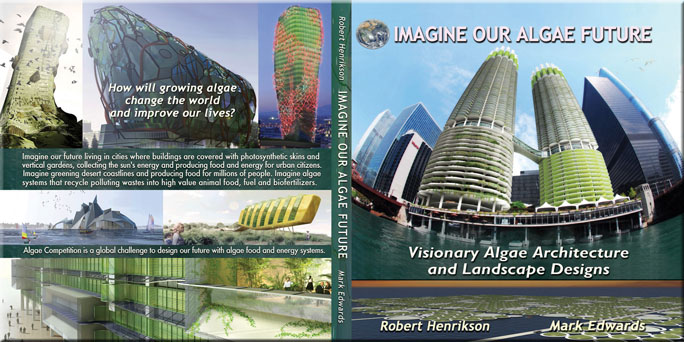
“Imagine Our Algae Future” (available at Amazon.com) reviews algae production, products and potential today and showcases the amazing visions of our future from the Algae Competition.
The International Algae Competition is a global challenge to design our future with algae food and energy systems. Participants from 40 countries around the world submitted 140 projects for algae architecture and landscapes, cultivation systems and food.
Algae Competition: The Future of Algae.
4:45 minute video introducing 20 visionary projects from the Algae Competition.
Beginning with algae pond systems and photobioreactors at the Arizona Center for Algae Technology and Innovation today, this video looks into our future, exploring emerging themes, schemes and dreams in algae architecture and landscape design. Let’s look into our future and see how algae systems from the Algae Competition could move into landscapes, living buildings with green photosynthetic membranes, and eco communities.(2012).
These complex algae systems requiring automated technology combined with modular growing systems may make it feasible to deploy microfarms and photobioreactors anywhere in the world without onsite expert algae technicians.
Automated sensing and control systems
Automated building systems with sensors and feedback loops control the complex interaction of building energy, lights, air, heat, cooling and environmental conditions. Algae cultivation systems will handle these functions and more – all the environmental parameters needed to grow algae, such as water quality, nutrient levels, pH, dissolved solids, culture density, temperature, light and so on.
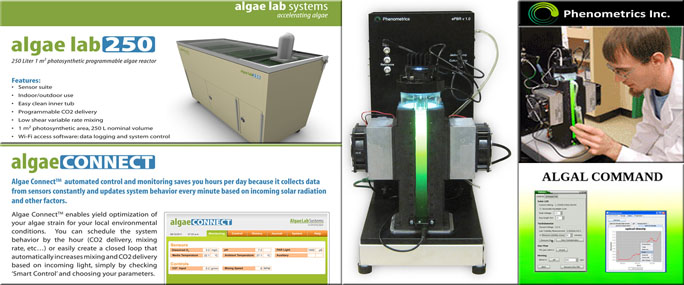
Algae Lab Systems and Phenometrics automated laboratory scale bioreactor systems.
A number of enterprises provide laboratory scale equipment and services for automated growing, monitoring and controlling algae. Algae Lab Systems of Colorado has developed a mobile programmable algae reactor with algae Connect™, an automated control and monitoring system that collects data from sensors constantly and updates system behavior.
Phenometrics of Michigan offers computer controlled bioreactors with data such as light, temperature, CO2, and growth rates monitored in real time by computer or internet allowing remote adjustment of the key parameters. More companies like these will provide the algae automation systems of the future.
Future visions integrating algae microfarms in daily life
Here are some future visions from the International Algae Competition incorporating algae systems in building design and microfarms in eco-communities of the future:

Algae Powered Mushroom Farm was voted the Appreciation Prize by participants in the Algae Competition.
Algae Powered Mushroom Farm.
3:45 minute video by 10 Design Group. (2011).
This mobile unit can be placed anywhere in the world to support micro-economic development in poverty stricken regions. The farm will grow mushrooms because of easy cultivation and high yield. Algae will be a food source and provide fertilizer. Two target groups are urban homeless and rural poor. Congo-Kinshasa in Africa was selected for the first farm. The farms are lightweight, easily shipped and hand carried to sites. Four farms can be shipped in a 40’ container. (Designed by 10 Design Group (10design.co), Ted Givins, tgivens@10design.co).
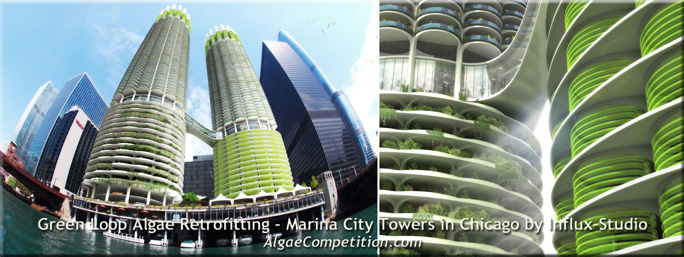
Green Loop Algae Retrofitting won the Abundance Prize in the Algae Competition.
The Green Loop: Marina City Algae Retrofitting.
6:28 minute video by Influx-Studio, Mario Carceres, Christian Canonico. (2012).
This is a proposal for one of the most innovative buildings in the Loop of Chicago: Marina City Towers. This algae strategy represents a new sustainable model in urban areas. Re-visioning an iconic building from the past century fossil fuel economy. This is an environmental vision committed to the Chicago Climate Action Plan. (Designed by Influx-Studio, Mario Caceres, Christian Canonico. contact@influx-studio.com www.influx-studio.com).
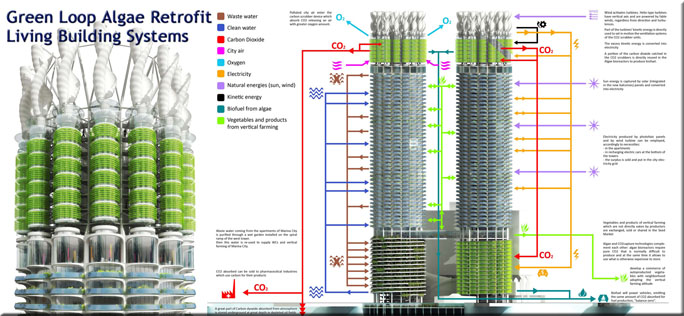
Diagram of the interaction of the various systems: absorbing CO2, growing algae, harvesting energy, filtering water and producing food onsite.
Eco Laboratory: Phase II Algae Microfarm Center, Seattle (2020engineering.com) is the heart of the community. This design is a living building with algaculture, hydroponics, aquaculture, aeroponics, aquaponics and farming. Includes rooftop garden, algae bioreactors, farmers market, community gardens, orchards and greenhouses.
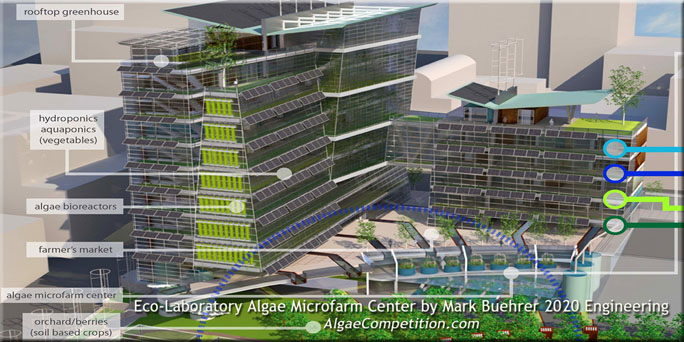
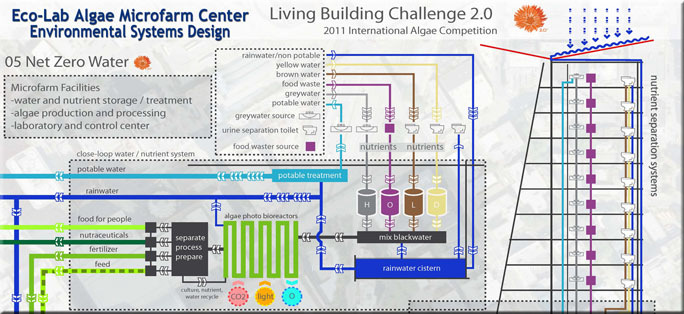
The Algae Microfarm Center was a finalist in the International Algae Competition.
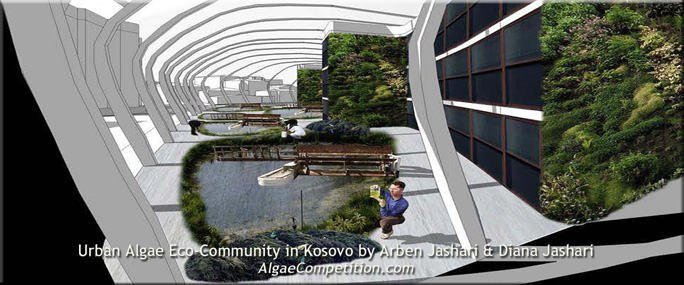
Urban Algae Bio-Fuel Production and Eco-Community in Kosovo. Designed for central Prishtina, with seven floors for residential space, each with a green garden. The community has a roof garden to grow produce, market, cinema and restaurant. The eco-community building is linked to the algae building with a glass roof to produce bio-fuel, food and compost.
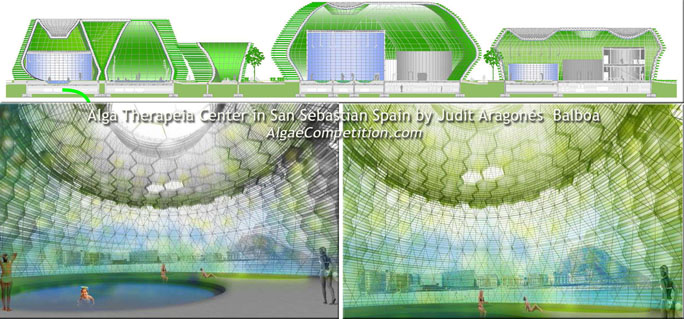
Alga Therapeia Center, San Sebastian, Spain. Design for a research center of marine algae typical of the Basque coast for medicinal, food and industrial applications. A photobioreactor skin generates the necessary energy for all building operations: therapy baths, solarium, kitchens, classrooms and research laboratory.
Is algae architecture just future fantasy or it is just around the corner?
Some have dismissed the integration of algae growing systems into building architecture as impractical or just speculation. Yet, the first living algae buildings will be introduced soon.
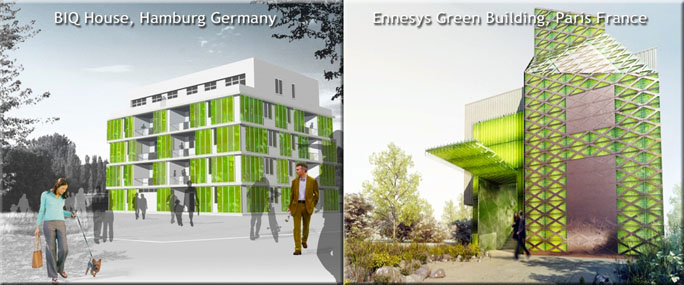
The world’s first bio-adaptive façade with living algae will be installed in March 2013. The BIQ House for the International Building Exhibition in Hamburg Germany is being designed to produce shade and energy by Arup and SSC or Germany. Ennesys will be launching a ‘truly green’ building in La Defense near Paris. The concept is to turn buildings into energy production using light, CO2 and wastewater to grow algae.
Emerging Smart Microfarms and Photobioreactors
Until now, successful algae cultivation and operation has required trained and experienced algae experts and PhDs on location. This knowledge level requires sophisticated and expensive staffing and infrastructure. Automated smart technology combined with modular growing systems will make it feasible to deploy algae cultivation systems, whether they are microfarms and photobioreactors, anywhere in the world without onsite expert personnel.
Remote monitoring would enable a central laboratory to support a large number of deployed units. The large user database feeds grower experience into the algae operating system that provides the knowledge base for an advanced learning system that offers process automation and an expert system that provides grower guidance.
Flexible microcrop platforms will produce food and valuable co-products locally by mimicking nature as they grow algae and other microorganisms integrating light and intelligent technology. This emerging technology will empower people globally to grow healthy food and co-products for the needs of their local community using more sustainable and affordable inputs.



 SPIRULINA
SPIRULINA